There is nothing easier than breaking a flyrod. Former fishing guide Roland Henrion describes 10 easy ways to do it for those who want to try. The advice can of course be translated into 10 ways of avoiding rod breakage if you don't.
Claude used to be a hunter as well as a fly fisherman. He owned a fine dog, a pointer called Cartouche (cartridge). Like all dogs do, as soon as his master got out the Wellingtons, he jumped in the car, its tail wagging with anticipation. When Claude gave up shooting, Cartouche thought waders were the same thing as boots and that's how invariably he accompanied Claude to the river.
On a fine day in May, Claude fished the river Tarn and as usual, Cartouche was minding his own business and inspected the opposite bank. He saw his master standing waist deep in the water doing funny things with a long wiggly twig.
"But wait a minute!" Cartouche thought. "What's that splashing in front of my master? And just look how excited he gets! Better check it out".
He jumped in the river and quickly swam across to where Claude was landing a hefty brown trout. More fish were rising in the pool and fearing his dog would spoil the spot, Claude started yelling at him: "go away, bad dog! You're scaring all the fish!"
Cartouche was confused: "As a hunting dog I am supposed to assist my master with the game, right? So what's all the verbal abuse for?" He froze in the middle of the pool.
Claude realized he would get nowhere with words and started to hit Cartouche with his rod tip... which promptly snapped!
This true story is an original way of breaking a rod of course, but no need to worry, there are many easier ways too as described below.
1. Slam a car door shut with the rod stuck in it
The fatal attraction between car doors and fishing rods goes back a long way. Actually, ever since men drove their cars to the river, instead of walking.
The start of a new fishing day is always full of excitement and anticipation. Quick, rig up the rod.
Oops, forgot a guide ring there, calm down, start again.
OK done.
Lean the rod against the car.
Pull on the waders.
Hey, it seems the breeze picks u...
Slam! (the car door)
Crack! (the rod)
Score: Car, one point. Rod, zero points.
Unless the angler took along a spare rod, he can drive straight back home, without even getting his waders wet.
The ONLY safe way to lean a rod against a car is with CLOSED front doors, the rod resting in the nook of the side mirror. The rear door is out of harm's way and the mirror prevents the rod from sliding on the ground. You can also buy a handy little magnetized rod holder to stick on the car's bodywork.
The car roof is also a safe place to put a rod, although rooftops are another curse, especially AFTER fishing. Reels, glasses, phones, permits, purses... we all have at least once in our fishing career driven off leaving something on the roof. My grandfather lost a rod that way and found it again... twelve years later, in the hands of another fly fisher. As the rod was custom made, grandpa recognized it immediately. Complimenting him about his fine rod, the man replied: "isn't she a beauty ? And can you imagine I found it here by the car park many years ago ? I never managed to trace the owner."
My grandfather being a real gentleman never told him the truth. He explained to me: "I could see the guy treated it well and it was obvious the rod was happy with him!"
2. Put the rod flat on the ground and stand on it
Laying a rod flat on the ground is just asking for trouble. Some stupid, half-blind idiot will surely step on it and if there is none around, you will find a way of achieving this yourself.
NEVER lay a rod flat on the ground. Period. Lean it against a tree, a bush, a bridge, a fence -- no, not an electrified one, because carbon is a good conductor. If there is nothing but grass around you, put the rod on your tackle bag. Even it doesn't stand up vertically, you would still have to lift a leg high up to step on the rod... and this is something you would never do, I'm sure.
3. Poke the rod tip in the ground while walking
The setting can be anywhere: a river bank, a beach or a flat. You can be alone, with a friend or accompanied by a guide. Whether you are observing the water in search for fish, daydreaming or chatting away with your companion, it doesn't matter. Point is, you are not paying attention and unnoticed, the rod tip goes slowly down and suddenly bores itself into the ground. If the walking pace is high, the sanction comes immediately: snap! If you walk slowly or your buddy stops you in time, you can get away with a warning.
How should you carry a rod ? Hold it horizontal but backwards. If you walk through an area with other people (parking lot or camping site) keep the rod up, but always check for wires or trees. Holding up a rod indoors is even more dangerous... especially in tropical areas where vicious ceiling fans patiently wait for a crispy rod to come into range and chomp it into pieces. "Have you seen my new 17-piece fly rod?"
Ever seen Davy Crocket holding his long barrelled rifle? That's also a comfortable way to carry your rod in open terrain: lay the reel in the palm of your hand and let the rod rest in the elbow joint. Handy tip: carry your rod with your non-casting hand to give the other a rest.
4. Hit the rod tip against a bridge piling or another hard obstacle
Bridges are always interesting places to fish around or even under. Ever tried to get that trout (must be a big one) steadily rising deep under the middle arch of the bridge? It requires a narrow loop and good line speed to reach the fish, so let's apply a bit more power and... clunk!
With the extra power put in, the rod swung further and hit the stone. Now carbon fibre is extremely strong and flexible, but hit it the wrong way, and it snaps like glass. Cold weather makes it even worse. If you fish in cramped areas, check the immediate surroundings well before casting.
Attention, danger!
Especially with large, weighted flies. Always pull on the line and never with the rod. The line may cut your fingers and even more so if your hands are wet. Turn away your face. It is recommended to slip the line under your foot so that if the fly comes loose, it doesn't shoot straight at you. Warn people in your vicinity.
Fly line and mono have up to 10% stretch, so if you are hooked up 60 ft away, that's 6 ft of stretch to pick up first... and a hell of a catapult you load! As a kid, fishing for barbel, I got caught on the opposite bank -- that's where all good fish are, didn't you know ? I pulled and pulled and finally the line gave way, shooting a split shot straight against my thumb. It turned blue and eventually shed the nail... I guess that is what learning the hard way means!
5. Try to pull free a tree-caught fly with the rod
Oops, caught the mangrove root there, my cast was just a few inches too long. Before going on, let's draw a parallel with golf here: when putting, if you don't accept to occasionally overrun the hole, you will always hit short. Same thing with fly-fishing. If you are afraid of hooking the trees, you'll never get the fly close enough to the bank. (Note: no, I don't play golf. I just heard it on TV and I thought it made a lot of sense).
So your last cast was just a touch too long and sent the fly spinning a dozen times around the mangrove root. You know you shouldn't pull with the rod, but you don't want to spoil this hot spot and you're a little nervous. It starts with a little tug, then a better one, quickly followed by a mighty haul and bang: the fly is still there, but the rod is no more.
If a few moderate tugs don't dislodge the fly, forget about the fish and get over there to unhook the fly. Or never mind the fly (you have a couple of thousands anyway) and break the tippet.
6. Choose a tippet too heavy for your rod
"Damn, this is the third grouper I lose to coral!"
I started with a 16 lbs tippet, but couldn't prevent the fish from diving under a coral head as soon as it took my Clouser minnow. When a second fly and leader were lost the same way, I switched to 20 lbs, but this still wasn't enough and another good fish was lost.
"I'm fed up with this little game, I will tie on a 30 lbs leader with 80 lbs shock tippet. That'll teach'em! OK, make a nice long cast, let the fly line sink towards the bottom and start stripping... Hey I think something touched it... Yesss!!! Wow, what a savage take! Feels like a good size grouper. Uh-oh, he's heading for the coral, but this time, Mr. Grouper, you ain't goin' nowhere... except in the boat."
Down below, the grouper felt the iron and made a mighty dash for its cave. In the meantime up on the deck, I blocked the reel and didn't give him an inch. I gave him half a rod instead... plus another fly!
You would be surprised to see how much power you can apply with an 8 weight rod and a 12 pound tippet. Experiment it yourself: hook the fly onto to a tree or fence and step back 60 or 70 feet. Now try to break the tippet holding the rod as if you were fighting a fish. Chances are you will stop pulling, afraid to break the rod. Note: if you do break your rod, I shall accept no blame!
Saltwater fish are powerful and fast. They force us to use the strongest possible rigs. Don't overdo it: remember a fly line has a breaking strain of roughly 30 lbs and so has your backing probably too. Using a 30 lbs tippet with an 8 , 9 or 10 weight rod is very risky business! If you really have to horse fish away from obstacles, go for a heavier rod.
7. Hold the rod the wrong way while playing a fish
"What?" your friend asks in disbelieve, "a tarpon broke your 12 weight rod? It must have been a monster!"
A fish lost in battle always feels big. One that brakes the tippet is huge. But what to think of the fish that breaks a rod ? Man, that must have been really something... or was it?
Let's face the cold truth: if a rod breaks in battle, it's 90.4% the angler's fault, 8.6% bad luck or 1% due to a fault in the rod (source: personal experience and a bit of guessing).
What about the fish, then? The fish is never wrong, buddy, he fights for his life!
No matter how you hold the rod, upwards or sideways or even with the tip lower than butt (known as fighting low and dirty), the one and only rule is to keep an angle of roughly 90 to 110 degrees between the butt section of the rod and the line. Close the angle and all the pressure comes on the rod tip. This is why rods often break while landing a fish. Or when the fish sounds close the boat while the angler keeps his rod high.
On the other hand, open the angle too much and all the pressure is concentrated on the lower part of the rod... exactly where the first ferrule is located. Need a picture?
Always make the rod perform completely, from tip to butt. When the fish is far from you, hold the rod up. As it gets closer, lower the rod to keep the same line/rod angle.
To bring a fish to the net without putting the rod tip at risk, stretch you arm backwards, instead of pointing the rod back. On a boat, step away from the gunwale to bring the fish in reach of the gaffer/netter. By moving back, you keep a safe rod angle and you also provide space for the mate. Last tip: to prevent the rod from hitting the gunwale hard when the fish makes a final dive, reduce the drag setting and clamp the reel instead, ready to let go if needed.
8. Assemble the rod without fitting the ferrules tightly
Gilberto is thrilled. This is his first ever sailfish on the fly! After successfully teasing the sailfish to the boat, I enjoy watching my client fighting his fish.
He is using his new Winston 5 piece, 12 weight and boy, does that sailfish pull a bend in his rod!
But wait a minute, the guide rings are not aligned, something is very wrong here. Gilberto's sailfish would never be a record of some sort*, so I tell him to hold the rod flat, pointing straight at the fish. This releases the pressure on the blank enabling me to re-align the rings and push the ferrules snug.
Gilberto could resume the fight and land his sailfish. Luckily I noticed the problem in time, because one of the loose ferrules would surely have broken.
Ferrules have to be tight, otherwise rod breakage may occur, even when casting. So check them frequently. Also don't do what my friend Eric did once: we were standing by the lake rigging up our rods. Eric had just bought a new Sage XP and he was very pleased with it. He "shadow cast" while bragging about the terrific action of his rod: "man, just look at this..." What I saw was the front section sailing into the water. Eric was demonstrating without fly line and forgot to tighten the top ferrule. Luckily, the tip didn't fly too far and floated just long enough for us to retrieve it...
*According to IGFA rules, nobody but the angler is allowed to touch rod, line or angler himself.
9. Hit the rod with a heavy fly
On Desroches island (Amirantes Group, Seychelles), standing almost waist-deep in the water, I try to get my Clouser minnow with heavy dumbbell eyes to the trevally chasing baitfish in the crashing surf.
Normally I can cast 90 feet without a problem, but today I'm struggling with a stiff sea breeze. All of a sudden, whack! The weighty fly hits my Sage RPLXi on the back cast. Judging by the sharpness of the sound, I fear the worst. I get out of the water and inspect the blank. Nothing to see, not a scratch, not a chip, nothing. "Wow, I was lucky", I thought and went back to the water to resume fishing. Exactly four casts later, the rod broke. I will never know for sure, but I can bet whatever you want that the breakage occurred precisely where the fly hit the blank.
How to avoid such painful experience? With heavy flies, don't try to cast an extremely narrow loop, but open it up a little. Let the back cast stretch out completely before making the forward cast. Hold your fire during wind gusts and take advantage of momentarely slacks. Go to the nearest bar and have a couple drinks, tomorrow will be a better day... No, just kidding, but be very careful with a wind coming over your casting shoulder. Use the backhand cast or turn away from the target and deliver on the back cast. Auch! Perhaps you should wear a helmet too?
10. Get in and out of boats with your rod in hand
The mate steers the dinghy alongside the 40 feet Sportfisher. You stand up and hop from the dinghy onto the rear platform...
At least you tried to, but you forgot you're not 25 anymore. Unfortunately you had two rods in one hand and a tackle bag in the other. All went flying as you desperately grabbed the gunwale and found your balance. The bag is fine, but one of the rods fell hard and broke. Thank God you brought two with you!
Boats and cars have this in common: they are rod breakers. Everybody knows (or should know) one must never board a vessel without being invited to by a crew member. Some might know the second rule: "always have one hand for yourself and one for the boat".
Far fewer have heard of this one (I might have invented it myself, by the way): NEVER get in or out of a boat holding a rod. Boats have a vicious tendency to move just as you are taking your step... and never the way you think.
So here's the way to do it: before stepping into the tender, give your rod to the person already in the boat or to the one who will board after you. If you are by yourself, lay the rods in the boat first and then climb in. Keep rods vertically to avoid painful encounters with jetties or boat hulls.
The transfer from the tender to the fishing vessel goes best like this: Wait for orders from the crew! There is nothing more frustrating for a boat handler to have all his passengers get up prematurely and at the same time. Remain seated in the dinghy until it is your turn to get out. Hand rods and bags to the mate onboard, get up, hold on to the gunwale and wait for the dinghy to be on the crest of a wave to step out. Don't refuse a helping hand, you wanna go fishin', no need to prove you were a gym champ at high school!
Conclusion
I hope you have enjoyed these tips on rod breaking. Follow them and soon there won't be a single rod left in your rack!
I can't resist to finish off with a true story which happened to my friends Serge and Serge (that's right, same first name).
They decided to fish the gorgeous gorges of the river Tarn, in the south of France. After a two hour drive, they parked the car, donned their waders and carefully descended the steep goat path down the gorges. 45 minutes later, soaking wet (damn waders) and out of breath, they reached the emerald waters of the majestic river.
After a rest and a drink to cool down, they pulled out their rods out of the socks. Serge's face went livid: he held up four pieces of what used to be a three piece rod!
Serge (the other one) told him not worry, they would share his rod and fish the pools alternatively, but Serge (the first one), thought otherwise.
He told Serge: "you start fishing here, I'll run up to the car and fetch my spare rod".
Serge tried to convince him not to go, but to no avail, Serge was already on his way (I hope you know which one went!).
When he got back one hour later, he was ghostly pale, his heart pumping in his throat.
Half an hour later, he was still out of breath and Serge (you know who) started to get worried for his friend. Slowly though, Serge started to feel better, colour coming back to his cheeks and his heartbeat slowing down at last.
They started fishing, but one Serge did better than the other as you can easily imagine. The day was called off prematurely and the climb out of the gorges was a slow one.
What happened to Serge's rod ? As usual, he grabbed it in his study and without looking, loaded it in the car. Later he found out the cleaning lady had broken it and she did not have the courage to tell him.
So the 11th way to brake a rod, and by far the easiest, is to have it done by someone else!
Good fishing.
Roland Henrion
Former fly fishing guide in Seychelles. Inventor of the Smart Spooler line winder and owner of Smart Fisher SA. Visit his website.
PS. I'm sure there are a lot of creative anglers out there who have thought of other ways to brake their rods. I would be happy to learn more about it and to prepare the next article entitled:
"Rod breakers, they're back!" or "The return of the Rod-Breakers!" or "The Rod-Breakers strike back!"
- Log in to post comments

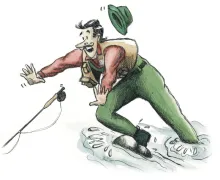
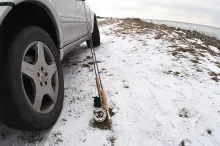
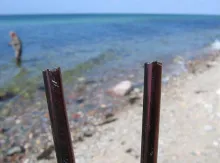
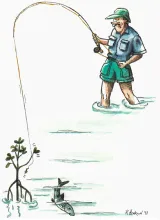
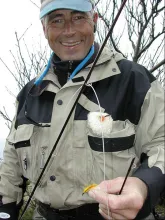
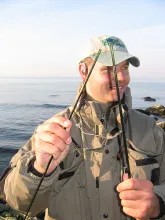
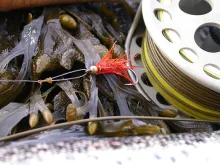
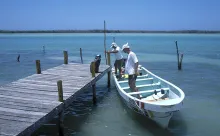
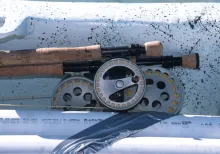

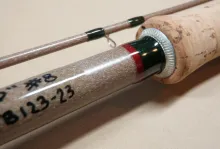


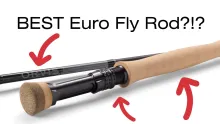

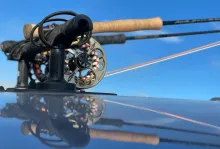

I thougtI had tried
I thougtI had tried every way possible way but here are several you also missed.After a days fishing close to home I took my superb bamboo rod down and put it in the back seat of my car, drove over to my gun club as I knew they were tapping a fresh keg
that night. By now it was quite dark I finally found a parking space, turned off the engine, thought I had better place the rod in the trunk for safe keeping, after all the members were tapping a new keg that night. The car was a Plymouth salsemans coupe, they did not waste money on items which were not required so the trunk had no light. I slammed the trunk lid and heard one of the most fearsome sounds ever that right the bamboo made the horrific sound of breaking, probably serves me riht I should have gone directly home. The first chance I got I decided that the rod could not be repaired, the only solution was to build a new tip.but who could match this marvel of a tip? I decided to take it to my hangout in New York's Abercrombie & Fitch.
I told you this was a superb rod. I woefully approached the sales clerck to determine if I could afford a new tip.The clerck
examine therod a reported that the break could not be reraired. He reported that the only recourse was to order a new tip.
I said that I did not even know who built this one. He certainly saw that I must have had a desperate look and he said that he was the rod maker and introduced himself as Mr. Edwards. I feared that he would not have the time available to make me a new tip.. When I broached the subject he told me not to worry, that he knew a fine youg rod builder who could do the job for about $25.00 I felt like lucky Piere.
This is a short story While fishing on the Mirimichi from a conoe I was using two rods an eight footer for Dry flies and a nine footer for wet flies. I handed the eight footer to my guideand asked him for the other rod which had an immitation shrimp pattern on it and requested that he put a green machine on the other rod. I was right about to "GP" as I quickly hooked a large salmon of about thirty pounds. My guide netted the fish and brought her aboard the boat. This was not to the fishes liking however and she jumped out of the net and started thrashing about the boat. When fishing from the canoe the fisherman sits facing forward and the guide sits behind facing forward. After the guide finally unhooks the fish he realeases the fish. The guide the poles the canoe to another pool and hands me the smaller rod it had the strangest feeling when casting, Upon examination the tip was demolished ust abve the fferrule. the large fish must have landed on the rod and broken it during the struggle.
I believe I have just reported a new way to destroy a rod
excellent view on ho
excellent view on how to break a rod as it happened to me ,rod still in bag while walking to fishing spot .slipped and fell me one way and rod the other, looked at rod at once, no damage, at least that is what it looked like,3piece then became 4piece
Comment on nr. 1:
S
Comment on nr. 1:
Sticking the rod out the electric car window and then closing the window gives a quick, precise and effortless result.
It helps to have a rod with a guarantee so you can upgrade when you cut the end off.
Comment on number 9.
Comment on number 9. A better cast using a heavy fly or bead head fly is the Belgium cast, i.e., a sidearm back cast coming into an overhead forward cast. Imagine drawing a capital letter "D" in the air. You don't get great distance but it sure saves the rod damage!